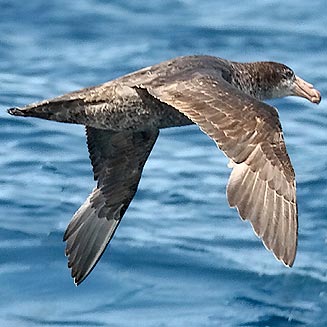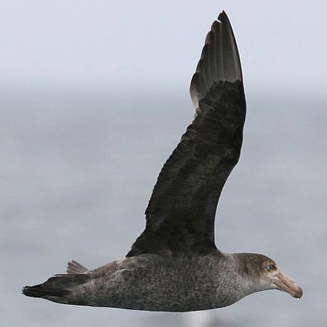|
Macronectes halli (Northern
giant-petrel)
Grootnellie [Afrikaans]; Noordelijke reuzenstormvogel
[Dutch]; Pétrel de Hall [French]; Nördlicher riesensturmvogel [German];
Pardelão-subantárctico [Portuguese]
Life
> Eukaryotes >
Opisthokonta
> Metazoa (animals) >
Bilateria >
Deuterostomia > Chordata >
Craniata > Vertebrata (vertebrates) > Gnathostomata (jawed
vertebrates) > Teleostomi (teleost fish) > Osteichthyes (bony fish) > Class:
Sarcopterygii (lobe-finned
fish) > Stegocephalia (terrestrial
vertebrates) > Tetrapoda
(four-legged vertebrates) > Reptiliomorpha > Amniota >
Reptilia (reptiles) >
Romeriida > Diapsida > Archosauromorpha > Archosauria >
Dinosauria
(dinosaurs) > Saurischia > Theropoda (bipedal predatory dinosaurs) >
Coelurosauria > Maniraptora > Aves
(birds) > Order: Ciconiiformes
> Family: Procellariidae
 |
 |
|
Northern giant petrel. [photo
Jeff Poklen
©] |
Northern giant-petrel, offshore from Cape Town, South Africa. [photo Trevor Hardaker ©] |
Distribution and habitat
Breeds on sub-Antarctic islands, after which it disperses
across the southern oceans, mainly staying within 30-64° South including in
southern African waters. Here it is fairly common off the southern and western
coast, while more scarce in the north-western corner of the region and off the
coast of southern Mozambique.
Movements and migrations
Present year-round in southern Africa, but
generally most abundant in winter, as most birds return to their
breeding colonies in August.
Food
Highly adaptable, as it is an omnivorous predator and
scavenger, usually foraging by grabbing prey from the water surface. It may also
dive to greater depths, hawk other seabirds aerially or even come ashore to
scavenge seal and whale carcasses. The following food items have been recorded
in its diet:
- Vertebrates
- carrion
- birds (killed at sea)
- fish
- Invertebrates
Threats
Near-threatened due to mortalities on longlines; it
now has a global population of approximately 11 500 pairs. However, most of its
colonies are thankfully increasing in size, probably corresponding to increase
in fur seal populations at its breeding colonies.
References
-
Hockey PAR, Dean WRJ and Ryan PG 2005. Roberts
- Birds of southern Africa, VIIth ed. The Trustees of the John Voelcker
Bird Book Fund, Cape Town.
|
